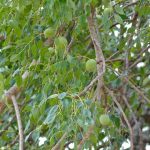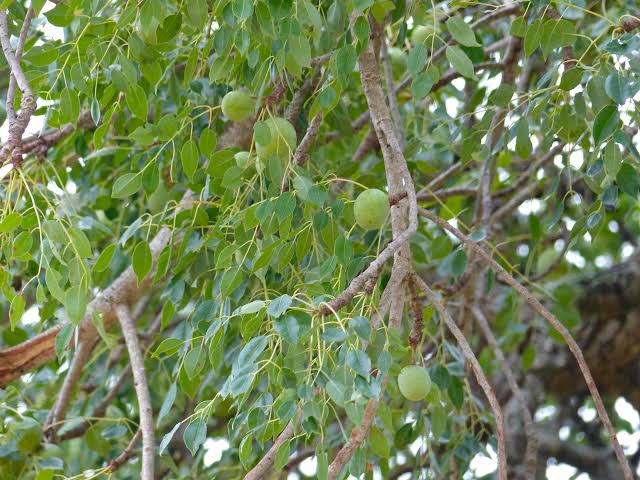Sclerocarya birrea or marula tree or Nunu or Danya (Hausa): A plant with nutritional values and medicinal uses
Occurrence and Description
Sclerocarya birrea or marula tree is a medium to large (15-20 m high), deciduous, with a wide crown and characteristic silvery, mottled bark, peeling in disc-shaped flakes. The Marula tree is in the same family, Anacardiaceae, as the mango, cashew and pistachio nut. The generic name (Sclerocarya) is derived from the Greek for hard (skleros) and nut (karyon). The small dark red flowers are unisexual and found in fragrant clusters at the end of the branches. The compound leaves are grey-green in colour, but turn pale yellow prior to being shed. Denuded of leaves, the top branches appear abnormally thick and erect, like upturned fingers (digitaliform).
The leaves attract many butterflies, including the magnificent green lunar moth, whose large silkworm-like cocoons, are used by Southern Africans, as ankle rattles for dancing. The tree remains bare for several months of the year. The plum sized fruits are covered in a soft, leathery, pale green-yellow exocarp which encloses the juicy white flesh. The fruit has an exotic flavour and a distinctive scent. The fruit contains a large hard seed, surrounding two or more edible kernels, rich in oil.
Marula trees are distinctive for their exceptional fruit and nut yields, making them very easy to harvest. In fact, this characteristic has not only been noted by humans, but also by elephants who will travel miles to gorge on the fruits. Importantly, the Marula fruit harvest occurs at the beginning of the school year making the cash income from their sale very important for the payment of school fees and clothing. The fruit of the Sclerocarya birrea tree has multiple uses.
Nutritional value of Sclerocarya birrea
The fruits are eaten fresh or fermented to make a beer. The proximate analysis of Sclerocarya birrea fruit revealed that it is very rich in ascorbic acid, with 100 g providing about 200 mg vitamin C (200% of recommended daily intake). The kernels are eaten or used to extract oil. The leaves are consumed by livestock and also have medicinal uses, as does the bark. Uses of marula Archaeological evidence has confirmed that the Marula tree has been a central part of the Southern African way of life for thousands of years; hoards of Stone Age Marula nuts have been found in Zimbabwean caves, with carved tools and piles of shells in close proximity (Hutchings et al, 1996). The same tools are used to this day to crack the stones and extract the kernels.
It is likely that the modern day uses for the tree have also been passed down the generations from Stone Age homo sapiens. Every part of the tree is utilised for an incredible variety of domestic needs. The fruits are edible, eaten either raw or made into a delicious jelly. They are also brewed into a popular beer; a marula liqueur is available commercially.
The kernels are either eaten raw or roasted, have a delicious taste and are regarded by many indigenous people as a delicacy, a ‘Food of Kings’. An oil can be also extracted from the kernels which is traditionally used for cooking, as a meat preservative and for skin care and hair applications.
Health benefits of Sclerocarya birrea
The bark is widely used medicinally to treat diarrhoea, diabetes, fever and malaria, and the roots are used to treat sore eyes. The leaves are used to make a relish, and the hard wood makes excellent kitchen utensils. It is the oil from the Marula kernel that has come to give the Marula tree its spiritual status. The kernels are so full of oil that a squeeze with the hand can release a rich yield.
This healing oil is used as a cosmetic, by Southern African women, and is massaged onto the skin of their face, feet and hands. Across the generations it has proven to protect against dry, cracking skin and in fact its moisturising properties are so effective that it is also used to treat leather and in preserving meat.
Hence within the Zulu tribe, the Marula tree symbolizes women’s fertility, softness and tenderness, and new-born baby girls are welcomed into the world with traditional Marula ceremonies. The kernel from Nigerian Sclerocarya birrea was found to contain 36.7% crude protein, whereas Sudanese Sclerocarya birrea contained only 28.0% of protein, with lysine as the limiting amino acid. The protein contains a good level of sulfur-containing amino acids (methionine and cysteine), when compared to that of four different food materials.
Marula oil contains a large proportion of mono-unsaturated fatty acids and natural antioxidants. It can be classified as a high-oleic acid (70-78%) with relatively low vitamin E content.
The exceptional stability has therefore been suggested to be due to its fatty acid composition. However, recent studies have mentioned that some of the minor components in the oil may also be contributing to this important anti-oxidant property. Marula oil contains a similar fatty acid composition to olive oil however it is 10 times more stable to oxidation. Easily absorbed, high proportions of oleic acid, as well as the essential linoleic fatty acid (4-7%) combine to make the oil ideal for topical application. Marula oil has also shown to improve skin hydration, clears acne, skin smoothness and reduce redness.
Marula kernels are also rich in minerals and vitamins. 100 g provide about 120 mg calcium, 460 mg magnesium (more than 100% of the daily recommended intake), 5 mg iron (50% of the daily value for men and 20% for women), 600 mg potassium, 5 mg zinc, 800 mg phosphorous (~90% of daily value), 0.40 mg vitamin B1 (~50% of daily value). Due to the high content of calcium, magnesium and potassium as well as low level of sodium, marula kernels can be recommended for patients with hypertension.

Credit: Wikimedia
Sclerocarya birrea is most widely studied with regard to its antidiabetic effect and the plant has shown hypoglycemic activity. The stem-bark ethanol extract was found to be used as complementary remedy in diabetes. Sclerocarya birrea was evaluated for the treatment of type 2 diabetes using in vitro models.
Complications are frequently encountered in diabetes and these are associated with irreversible functional and structural changes in various organs, particularly the kidneys, eyes, nerves, heart, and blood vessels. The extract caused significant reduction in blood pressure in anesthetized and conscious normal and diabetic rats. Sclerocarya birrea is used in folk medicine for the treatment of inflammatory disorders. Sclerocarya birrea is one of plant species used widely in traditional medicine in Africa against many diseases and affections, such as hypertension, dysentery, stomachache or gastroenteritis.
In some African countries, the stem bark, roots, and leaves of Sclerocarya birrea are used for an array of human ailments, including malaria and fevers, diarrhea and dysentery, stomach ailments, headaches, sore eyes, toothache, backache and body pains, infertility, schistosomiasis, constipation, abdominal cramps and some other unspecified gastrointestinal problems, toothaches and swollen or infected gums, cough, hypertension, arthritis, proctitis, epilepsy, diabetes mellitus, sores, boils, carbuncles, abscesses and certain other bacterial infections. In East Africa, roots are an ingredient in an alcoholic medicine taken to treat an internal ailment known as kati, whereas the bark is used for stomach disorders.
These are the thoughts of:
Sa’eed Halilu Bawa
Senior Lecturer (Associate Professor) at University of the West Indies, St. Augustine Campus, Trinidad.
Studied Food and Nutrition Sciences, Dietetics at Kaduna Polytechnic, Nigeria; Warsaw University of Life Sciences, Poland.
























